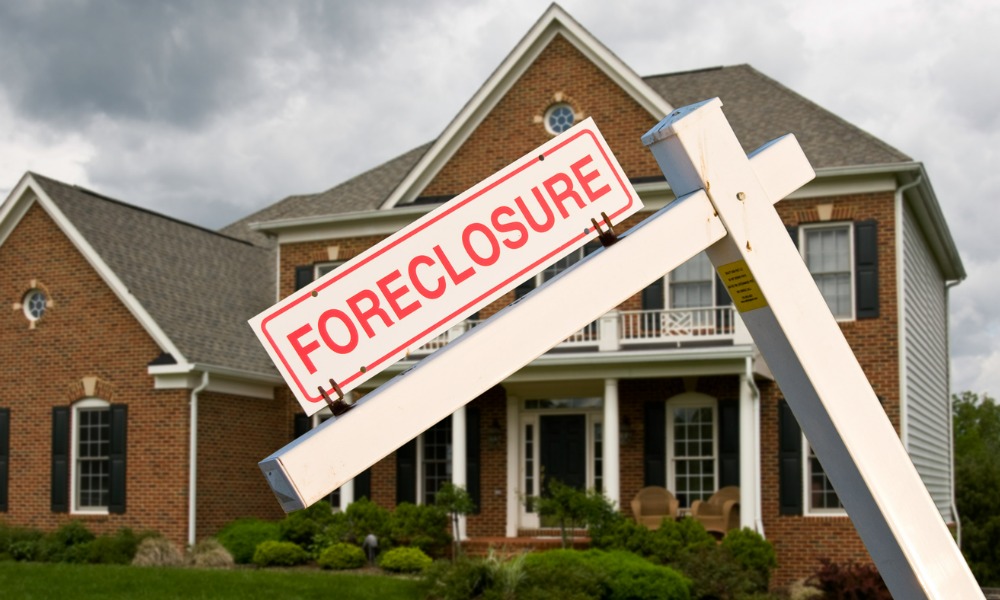Increase coincides with lifting of CFPB restrictions

More properties were in foreclosure filings in the US than at any time since the beginning of the COVID pandemic, according to a report by property analytics firm, ATTOM.
The January Foreclosure Market Report, compiled together with ATTOM subsidiary RealtyTrac, shows that a total of 23,204 properties were in foreclosure filings, including default notices, scheduled auctions and bank repossessions, representing a significant 139% increase compared to a year ago and by 29% from a month ago.
In addition, lenders started the foreclosure process on 11,854 properties last month, up 29% from in December and 126% from a year ago.
Read more: What’s happening with forbearance and delinquencies?
Foreclosure activity refers to properties with foreclosure filings, namely those that have been taken back by lenders after borrowers fall behind on their mortgage payments. Data typically includes information on default notices, public foreclosure auctions, and bank real estate owned completed foreclosures (also known as REOs).
Data was collected from more than 3,000 counties across the country, accounting for more than 99% of the US population.
REOs also hit the highest level of foreclosures since March 2020 and were continuing to rise, the report noted.
Lenders repossessed a total of 4,784 properties through completed foreclosures (REOs) in January, up 57% from last month and a staggering 235% from last year. This was also the seventh consecutive month with an annual increase in completed foreclosures.
States with at least 100 or more REOs which experienced the biggest monthly increase during the same period, included Michigan (up 622%), Georgia (up 163%) and Texas (up 98%). The highest foreclosure rates were in New Jersey, where one in every 2,336 housing units had a foreclosure filing, followed by Illinois, and Nevada.
Nationwide, one in every 5,922 housing units had a foreclosure filing in January 2022.
Among the large metropolitan areas with more than one million inhabitants, those with the worst foreclosure rates included Chicago, (one in every 2,514 housing units), followed by Las Vegas (one in every 2,654 housing units), and Miami (one in every 2,731 properties).
Metropolitan areas with populations in excess of 200,000 that saw the greatest number of REOs included Detroit, in Michigan, with 1,013 REOs, followed far behind by Chicago, Illinois, (210) and New York (129).
Read more: Foreclosure activity hits new low
In response to the report, Rick Sharga, executive vice president of RealtyTrac, downplayed the importance of the data, saying that the increased level of foreclosure activity in January “wasn’t a surprise”.
He said: “This year, the increases were probably a little more dramatic than usual since foreclosure restrictions placed on mortgage servicers by the CFPB (Consumer Financial Protection Bureau) expired at the end of December, (but) foreclosure completions are still far below normal levels – less than half as many as in January of 2020 before the pandemic was declared, and about 60% lower than the number of foreclosure completions in 2019.”
He added that there would likely continue to be “large year-over-year percentage increases for the rest of this year” and that foreclosure activity would remain below historically normal levels until the end of 2022.
Sharga’s views are in line with those of other industry observers, such as Marina Walsh, vice president of industry analysis for the Mortgage Brokers Association (MBA), who said as far back as August 2021 that she did not expect to see widescale foreclosures.
At the time, she pointed out that although foreclosures could be started in certain circumstances, with the CFPB stepping in, servicers “were going to walk very gingerly in terms of making sure they complied with all the terms and conditions to be able to move forward”.
She stressed, though, that even without the limitations imposed by the CFPB, there would not be massive foreclosures.



